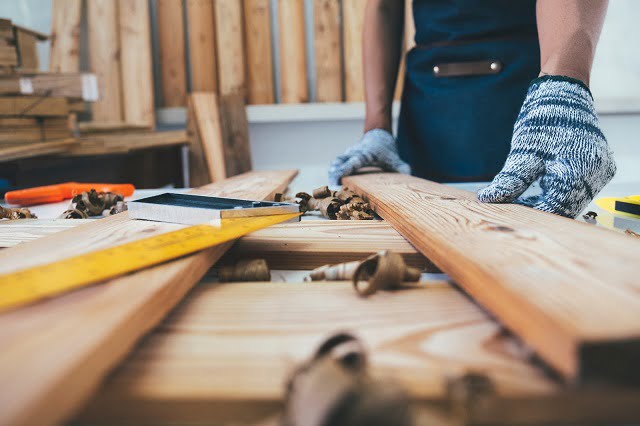
Time-saving woodworking techniques are the key to making quality woodwork quickly and easily. Rarely do skilled carpenters have the luxury of spending weeks or months on a single piece of furniture, so having some time-saving tricks up your sleeve can be extremely helpful in this line of work.
These strategies can make the production process more efficient, accuracy levels higher, and decrease labor times significantly. To get started, let’s explore three major methods you can use for fast and effective results.
One of the most important time-saving woodworking techniques is material selection and pre-measurement. Choosing the right materials before you begin construction will make all the difference in achieving high-quality products in a short amount of time.
This involves selecting pieces that are uniform in size, shape and color which require as few steps as possible for assembly or finishing. Making preparations ahead of time like obtaining tools, supplies and estimating lumber sizes all help create an efficient workflow that won’t slow you down while building projects.
An organized workspace also plays an integral role in saving time during a woodworking project. Having easy access to all tools, machines, measurements and necessary materials greatly accelerates the journey from design to completion.
Managing your work area with labeled bins instead of laying things out on tables will keep your station clean and allows quicker setups without fumbling around for components each time work needs to be done. By creating an ergonomic space tailored to a specific task, craftsmen can quickly transition into another job without losing precious seconds having to reorganize tools constantly throughout production phases.
Finally comes the simplest step though often overlooked; paper trails should be employed whenever possible into an existing workflow streamline routine tasks such as cutting lists, material orders or assembly instructions into concise charts that clearly outline what needs to be done at each stage of production for optimum efficiency Levels.
These are just three basic tips that every beginner should take into account when starting their journey in constructing fine wooden works with minimal effort. Following these principles carefully will yield excellent results soon enough Along with increased proficiency checking on safety issues consistently helps reduce risks employee injury rates while increasing productivity times.
We’re certain if applied correctly The woodworker’s performance levels could skyrocket leaps bounds coming close success they desire shorten turnaround items would away without compromising quality craftsmanship.
Advantages & Disadvantages of Time-Saving Woodworking Techniques
When undertaking a woodworking project, it is important to consider the pros and cons of different time-saving woodworking techniques. These can be split into three categories; joinery, shop machinery and handtools.
Joinery
Joinery is the process of connecting pieces of wood together with reinforcing hardware or glue. There are a number of different joint types used in woodworking such as mortise & tenon, dowel joinery, biscuit joinery, pocket hole joinery and miter joinery. Each has its own set of advantages and disadvantages depending on the project being undertaken.
- The strength of the joint makes it ideal for structural applications.
- The joint is often invisible from the outside which adds an aesthetic appeal.
- It can provide hassle free assembly.
- Making precise joints requires skill and practice.
- Installing a joint incorrectly may cause structural issues over time.
Shop Machinery
Shop machinery consists of stationary tools that are designed to speed up an operations procedure while still maintaining accuracy and precision. These tools use powered motors to rotate blades or bits with either manual control or automated CNC programs. Some examples include table saws, routers, planers and sanders.
- Highly accurate cuts can be achieved quickly.
- The ability to automate complex motions that would otherwise be difficult to complete by hand.
- These machines have safety features built in to prevent accidental injury from occurring.
Rules of Thumb for Time-Efficient Woodworking
Woodworking is an art form and a craft, requiring patience, attention to detail, and an eye for design. There are many tips and tricks employed by experienced woodworkers to get the job done quickly and efficiently. By employing these techniques, one can cut their overall project time while still creating quality work. This article will outline some of the top time-efficient woodworking tips.
- Take Adequate Measurements – Taking precise measurements before starting a project will save time in the long run. It’s important to account for discrepancies between lumber sizes during cuts or adjustments.
- Be Cautious With Joints and Glue-Ups – Pay close attention when fitting pieces together, as even small differences in size can cause time consuming joinery problems down the road. Use only small amounts of glue at once so that parts fit together precisely.
- Use the Right Saw Blade – The right saw blade makes a huge difference in cutting speed and accuracy when crafting furniture or other items from wood. Crosscut blades are most commonly used when making straight cuts, while panel blades are better suited for intricate projects.
- Turn Up the Speed – Adjust your power tool settings to a higher speed setting whenever possible. For example, most router bits cut much faster using an 8000 rpm setting instead of 4000 rpm.
- >Utilize Clamps > – Using clamps whenever gluing multiple pieces of wood together is essential for efficient use of your adhesive and fast drying times. Keep several lengths on hand in various sizes that are suitable for different types of projects.
- >Set Up Jigs For Repeatable Results > – Re-usable jigs which hold screws and dowels in consistent positions can be created out of scrap material or purchased commercially. They save time by making setup easy while allowing you to produce identical parts over and over with little effort.
- >Sand Professionally > – Spending extra time sanding each project ensures smooth surfaces that don’t require further refinement later on. Sanding between coats of finish can also make projects look more polished without having to apply subsequent layers.
Must-Have Tools for Speedy Woodworking Output
The key to success in woodworking is having the right tools for the job. Good quality tools save time and make any task easier. Regardless of the project, there are a few important tool categories that every woodworker should pay attention to. Firstly, it is essential to have a good quality hand saw.
These can be used for cutting through wooden boards quickly and efficiently and will make any task faster than when using knives or scissors. In addition, an orbital sander can be helpful for sanding surfaces down evenly; improving both the finish and the overall look of the piece. Finally, a drill with multiple bits is necessary for creating precise holes and cuts into smaller pieces of wood; allowing for decorative effects or functionality that would be impossible without them.
Power Tools Increase Speed
Power tools such as electric saws, drills and routers provide a much faster options for finer tasks than their manual counterparts and provide more control over precision cutting and sanding. When looking for power tools, consider both corded options – which are typically more powerful – as well as cordless options – which allow for easier mobility around sites where outlets may not be easily accessible – depending on your needs.
It pays to invest in higher quality products from trusted manufacturers, since poor quality can often result in disasters at best or accidents at worst.
Clamps Make Measurements Easy
Clamps are one of the most important time-saving investments when it comes to woodworking projects. They keep objects stable while gluing or screwing them together, preventing unnecessary movement which can cause materials to warp or uneven surfaces resulting in flaws that could take hours to fix after assembly process has finished.
Clamps are also useful when making measurements between joints; they keep materials straight during marking off making things quicker and less error prone than trying to do so by hand. Clamps come in various sizes so make sure you get something appropriate for each project you’re undertaking.
Techniques & Strategies to Make Woodworking More Efficient
In woodworking, time is of the essence when working with raw materials; a longer period of labour can result in wasted time and resources. By utilizing some helpful techniques and strategies, it’s possible to save both time and effort while producing a beautiful, professional end product. Below is a list of ways to accomplish this goal:
- Correctly Measure Material: It’s important to accurately measure material before beginning projects as mistakes can waste valuable materials and time.
- Experiment with Tools: There are often unique uses for woodworking tools that many people overlook. Take the time to experiment with different tools, methods and techniques.
- Organize One’s Space: Keeping one’s workshop organized reduces the risk of losing necessary items or tools during projects.
- Make Buy Efficiently: Knowing what type of board is needed for each project can help workers cut down on buying extra materials they don’t need.
Organization starts the moment before work begins as workers should sort and store their equipment so that they’re able to access them quickly when needed. When buying necessary supplies such as boards or lumber, understanding which types they need according to their intended usages will prevent extra purchases that may go unused.
The next step involves moving onto specific processes within individual projects, starting with correctly measuring materials for each task. Having specific measurements established beforehand helps maintain accuracy throughout construction so that problems relating to sizing won’t arise later on.
Apart from organization and taking accurate measurements other helpful tips include learning new methods in which existing woodworking tools can be used, such as sanding at different angles or cutting with jigsaws in unexpected ways. Mastering specialized tricks like these can help speed up parts of a project where otherwise tedious handwork would be involved, saving significant amounts of labour overall.
Utilizing all these practices together make woodworking more efficient by creating shorter timespan for tasks while increasing overall precision A higher quality final product is then produced without having invested large amounts of excess investment into its creation.
Popular Automated Aids to Help Speed Up Woodworking
One way to save a lot of time with woodworking is by using automated aid machines. Machines such as planers, routers, and jointers can help to cut, shape, and smoothen wood pieces in far less time than it would take with traditional hand tools.
Planers are used to make the surface flat and even while router bits can be used to bore holes or carve complex shapes into the material. Jointers help align the edges correctly so that they will fit together evenly when assembled.
The right type of automated aid machine depends on the task being completed and how accurate it needs to be. A basic handheld router can work quite well for most general tasks while jointers require more precise measurements in order for them to do their job properly. Planers come in both stationary formats and sliding beds, which are ideal for more detailed projects such as furniture making where truly precise dimensions need to be achieved.
Using Benchtop Models
For smaller projects, benchtop models can often serve as an adequate alternative for larger machines. These models typically provide the necessary strength for most daily tasks but lack some of the accuracy larger models offer, making them best suited for casual use only.
For instance, a benchtop router might not have enough power or depth control settings if someone wants to accurately carve intricate designs into a piece of lumber. However, they will work well enough for standard cuts or grooves and are far cheaper than their full-sized counterparts too.
CNC Cutting Machines
For really advanced projects that need high levels of accuracy and multiple operations carried out simultaneously a computer numerical control (CNC) cutting machine may be required. These machines run via a set of computerized instructions programmed either manually or imported from CAD drawings created on a computer program beforehand.
The advantage here is that complex multi-plet operations like cutting slots holes through multiple faces of wood can all be done in one cycle reducing completion times significantly over what would be possible by hand alone.
Key Takeaways for Saving Time with Woodworking
Woodworking can be a fun and rewarding hobby, allowing you to create unique pieces of furniture and other projects with your own two hands. However, it can sometimes take a very long time for all the precision cutting, assembly, and finishing needed for quality woodworking projects. The good news is there are several techniques that allow you to save time while still making excellent woodworking items. Here are some key takeaways about ways to quickly churn out beautiful wooden pieces:
1. Understand Your Tools: Knowing what tools you need for a particular woodworking job will help you complete projects efficiently. It is important to know how to properly use each tool in order to avoid any injuries or wasted time as well as ensure accuracy in your cuts or finishes. Make sure that each tool is well maintained and sharpened as dull blades cause more errors than expected while continuing working with it.
2. Prepare Your Project: To make sure the project runs smoothly, proper preparation is key. Preparing your project first means that all parts will be laid out nicely ready when most of the steps are performed; this reduces potential headaches further along on the way, such as misalignment, incorrect dimensions etc This initial step also makes for an organized workspace leading to efficiency when handling various processes throughout your construction.
3. Use Quality Materials: Quality materials will dramatically reduce do-overs on the project due to its inability to bear weight or damage due to humidity/temperature changes during aging. Using higher quality materials also increases life span which saves money in long run despite its higher price tag initially. Furthermore, quality materials sustain better craftsmanship look throughout multiple sessions of use which adds another layer of satisfaction in completion of woodwork.
Overall, understanding the different techniques consistent with efficient woodworking is essential for saving time while completing durable projects. Specific tools and quality materials should always be used in order for optimal success while maintaining a safe work environment. Additionally, setting up procedures before beginning new wooden pieces will help keep everything organized so everything runs smoothly without having unnecessary interruptions due to improper application of resources or projected plan layout designs.
Conclusion
The many woodworking techniques explored in this article can undoubtedly help by allowing the amateur and experienced woodworker alike to achieve professional workmanship within a much shorter timeframe. The key is to find the right balance that works for every individual, with the understanding that mastering certain skills will take time and countless trials over a longer period. As mentioned before, certain elements of safety should always be taken into account when beginning any woodworking project.
Understanding particular shortcuts and techniques for prepping, cutting, assembling and finishing woodwork can save significant amounts of time while still delivering a satisfactory result. Most importantly, it’s important to remember to always stay focused on the end goal – delivering a professional wooden product in the shortest amount of time possible.
With the aim of efficiency at heart, learning how to use power tools and other woodworking machinery correctly are essential aspects of quality woodworking regardless of whether you’re an amature or an experienced worker.
Finally, there is no one-size-fits-all approach when it comes to saving time while creating professional quality woodwork; rather it takes practice and experimentation in order to determine which routines will work best for every individual situation. It’s all about optimizing each step and utilizing specific techniques in order to find the most efficient solutions along the way.
By corresponding different approaches with certain levels of skill, anyone from rookie hobbyists can access pro-level craftsmanship in no time flat.




